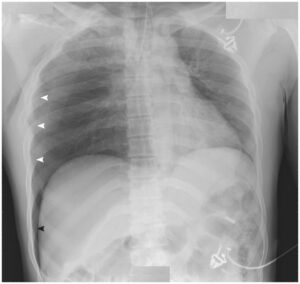This patient presents with a giant congenital melanocytic nevus. Congenital nevi are categorized by the final size in adults defined as small nevi <1.5 cm in diameter, medium congenital nevi between 1.5 and 19.9 cm, and large or giant congenital nevi >20 cm in diameter.
In newborns, nevi at least 9 cm on the scalp and 6 cm on the trunk are considered to be giant congenital nevi. Some have described a fourth category for nevi >40 cm in diameter in adults, also known as the garment nevi.
These melanocytic nevi, as the name implies, are present at birth and consist of proliferations of benign melanocytes. The estimated incidence of giant congenital nevi is 0.005%. Over time, congenital melanocytic nevi can acquire a pebbled surface with raised areas, colour darkening and papules and nodules, also known as proliferative nodules.
Neurocutaneous melanosis is observed at a higher frequency in patients with giant congenital melanocytic nevi, especially in nevi with a posterior axial location involving the head, neck, back and/or buttocks.
Neurocutaneous melanosis can be either asymptomatic or symptomatic, with signs of increased intracranial pressure due to hydrocephalus or mass effect. On magnetic resonance imaging (MRI), neurocutaneous melanosis can present with multiple postgadolinium-enhancing masses, diffusely thickened leptomeninges or focal areas of increased signal on T1-weighted images.
All congenital melanocytic nevi can be associated with melanoma, but the risk of melanoma is higher in larger melanocytic nevi. Across several large-scale studies, the risk of developing primary cutaneous melanoma within giant congenital nevi ranges from 2.5% to 12%.
In patients with neurocutaneous melanosis, leptomeningeal melanomas can arise, usually involving the frontal and temporal lobes, and are associated with very poor prognosis.
Treatment
For small- and medium-sized melanocytic nevi, routine excision is typically not recommended due to the low melanoma risk associated with these lesions. However, some may seek treatment due to the cosmetic appearance or location of the nevus.
For the treatment of giant congenital nevi, treatment can be more challenging. Excision is typically delayed until at least 6 months of age. Excision for large lesions on the back such as in this patient is usually performed in stages.
Other potential treatment options include dermabrasion, repeat curettage or laser treatment. However, scarring, prolonged healing and recurrence of pigmentation are drawbacks to these methods.

